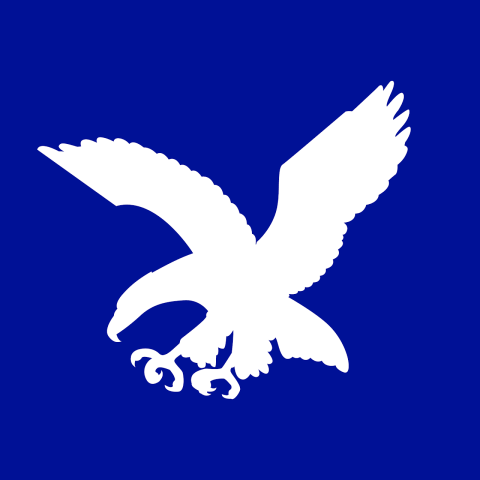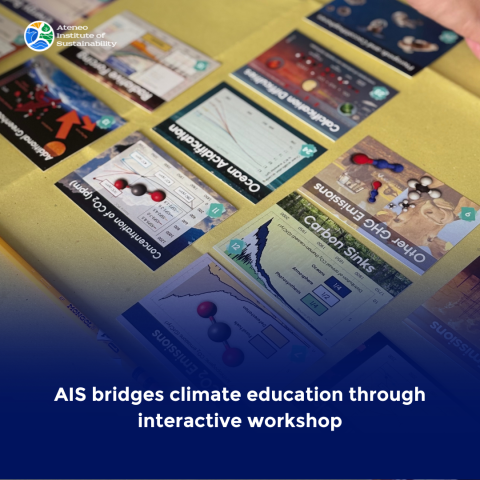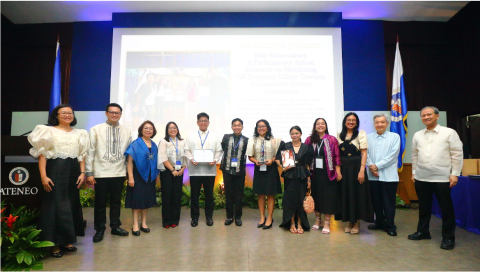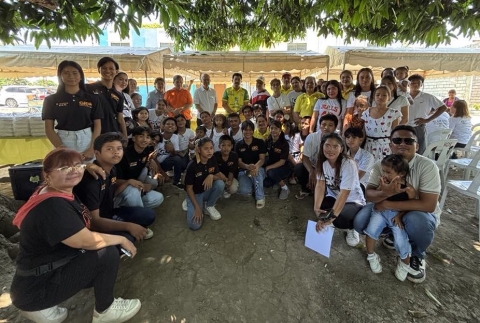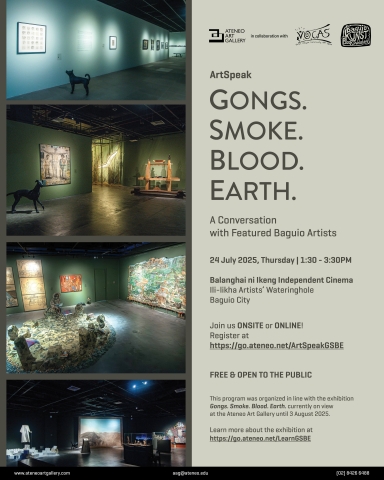Former Dean Tony La Viña shares life lessons to ASOG's Graduating Class of 2022
19 Dec 2022
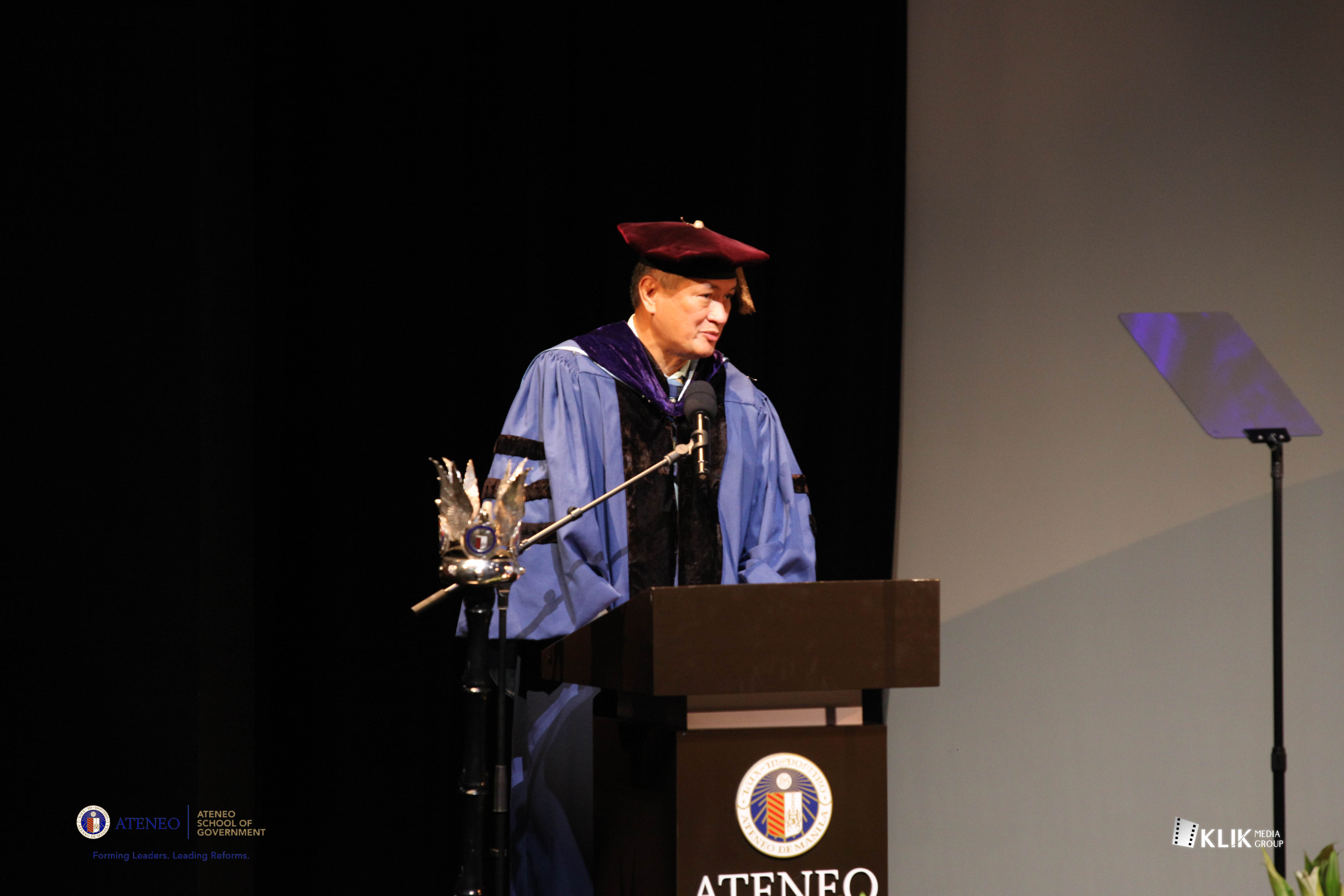
Antonio Gabriel M. La Viña, JSD
Commencement Speech
Ateneo School of Government Commencement Exercises 2022
Imperatives of a happy life: stories, virtues, and gestures
Ms. Bernadine Sy, Chairman of the Ateneo de Manila University Board of Trustees, Father Roberto C. Yap, our President, Dr. Marlu Vilches, Vice President for the Loyola Schools and the Ateneo Professional Schools, Dr. Ronald Mendoza and Dr. Randy Tuaño, Deans of the Ateneo School of Government,
My wife Titay and sons Eman, Rico, and Rafa, my fellow professors in the Ateneo School of Government and the University,
Dear graduates and your loved ones, friends, ladies and gentlemen,
Magandang hapon po sa inyong lahat. Isang mainit na pagbati ng pasasalamat at pagkakaisa.
I know why I was chosen to deliver this speech. I was in the Faculty Meeting when the topic of who would be the commencement speaker for our first live face-to-face graduation came about.
I was not paying too much attention when suddenly I saw a message from Fr. Pat Falguera in the chat box, suggesting that it should be Dean Tony who should be the commencement speaker. Like Fr. Pat, I also had a near death experience and would have something unique to say.
So yes, I will share some insights from that experience.
But first let me share stories with you from six decades of engagement and service. From these stories, starting when I was 15 years old, I will extract virtues and gestures that I consider imperatives of a happy and meaningful life. I will offer these to you dear graduates as my pabaon.
At 15 years old
In 1974, I was a high school student in Xavier University-Ateneo de Cagayan. I was an ok student, not particularly outstanding, certainly not an honors student, not even a leader. But then something happened that year – the great war between the central government in Manila and the Moro National Liberation Front.
My home city of Cagayan de Oro became a critical area for both our military and for the rebels and for people directly affected by the war, not a battleground but a place for rest and recreation and a place where evacuees congregated to escape conflict.
I noticed that many of our graduates are from the Armed Forces of the Philippines and the Philippine National Police. You would know the dynamics when war happens and people are uprooted from their homes. Many lose everything. Life becomes uncertain. Many questions are asked.
In 1975, as I entered senior year of high school, I immersed myself in activities to help refugees – feeding and providing relief goods, helping young children with their disrupted education, and sadly helping bury those who died in the refugee camps.
War made me a leader, gave me a calling and mission.
I began asking serious questions about our island, Mindanao, and our country and world. Why was this war happening at all? Why could people be so violent? Who was at fault? What can we do to stop this?
I asked hard questions about the Marcos regime, about Martial Law. I read pre-martial law magazines like the Free Press and Graphic. I got access to underground publications exposing the truth about the dictatorship that had taken over the country.
At 15 years old, I became a social activist and said yes to a mission to build another world, a better world.
48 years later, I have kept that activist perspective and have tried to be faithful to that mission.
I protest the poverty of our people, the inequality and social injustice in our society, and the corruption that continues to government and the private sector.
I am a human rights lawyer, an indigenous peoples’ and especially a Lumad advocate, and a climate and environmental justice champion.
It does not matter that I am redtagged for this.
A former undersecretary and spokesperson of the NTF-ELCAC has even accused me of being a member of the central committee of the CPP-NPA.
Having worked for almost all our post-EDSA Presidents, a consultant of several senators and government agencies, and a professor of dozens of military and police officials here in ASOG and in many law schools as well as many government officials of all levels, that would be an absurd accusation.
Co-founding the Legal Rights and Natural Resources Center, the leading environmental justice organization of the country, and the Samdhana Institute, that gathers activists and scholars in Southeast Asia for the Social and Environmental renewal of our region are two accomplishments I would always be proud of.
As a teacher, I challenge my students, and that include many of you, to see our society, government, and politics for what it is, with all its structural defects and failures.
But protest is not enough.
The war in Mindanao and the martial law experience opened my eyes yes but it also encouraged me to understand the roots of our dysfunctional society and to find solutions to overcome them.
Years later I would be appointed by several presidents in the government peace panels that negotiated with the MNLF as well as the Moro Islamic Liberation Front.
Through the years, I also assisted in our negotiations with the National Democratic Front of the Philippines, for example in drafting the government version of the comprehensive agreement on socio-economic reforms or caser in the latest round of peace talks which President Duterte eventually abandoned.
I believe in peace processes and that we must work for a peaceful settlement of all conflicts in this country. That was my take-away in working for our only president with a military background, Fidel V. Ramos,
Twenty years later
This brings me to my second story, which happened when I was in my 30s. In 1996, I became a young undersecretary appointed by President Ramos to the Department of Environment and Natural Resources. I had no political and not even personal connections to FVR and to then DENR Secretary Victor Ramos, who was also from Pangasinan but not related to the President.
But Secretary Ramos or Vor as we called him gave me an offer I could not refuse. Join us at the DENR and you can implement your ideas about environmental protection and mainstreaming human rights, community based natural resources management, and the rights of indigenous peoples into government policies and decisions.
His offer came with a bonus – I would be assigned to lead the climate change response of the Philippines.
I had just finished my doctoral dissertation on climate change in Yale Law School and I was eager to try out my ideas on how to address globally and domestically what was then an emerging problem.
And so in December of 1997, I was the lead negotiator of the Philippines in the Kyoto Protocol Negotiations in Kyoto, Japan. I was even appointed as a facilitator in one of the most contentious issues of the conference – on forest and land use emissions.
I worked with the great Filipina Diplomat Bernaditas Muller, who died in 2018, and together with the right mandate from FVR and Vor, we positioned the Philippines to play an influential role in Kyoto.
While we were in Kyoto, US President Bill Clinton called FVR to ask for our help in concluding a good agreement. Weeks after the protocol was adopted, Clinton actually called Ramos to thank him for the role our delegation played in Kyoto.
Twenty five years after Kyoto, what was known as COP 3, I continue to work on climate change. Just last November, with Fr. Jett Villarin and a team from the Manila Observatory, we went to Egypt to attend COP 27 in Sharm El Sheikh. This was my 23rd conference of the parties, missing only four.
Twenty five years after Kyoto, the State of the Climate has become a crisis, an emergency, with the Philippines one of the most affected.
Twenty five years after Kyoto, we are still fighting to achieve climate justice and while we succeeded in cop 27 to win a decision on loss and damage funding, emissions continue to grow and we are hurtling to catastrophic scenarios for our planet and country.
In my climate work, and in my governance work, in general, I have learned that four c’s are paramount: competence, creativity, consensus building skills, and commitment over the long haul.
Whatever government office or field of work you are in, the dramatic moments are few and not so often. It’s the daily grind, the patient progress you make on your assigned tasks and targets, and the knots you untie one problem at a time - that matters.
Our governance problems are complex but they do not require rocket science to solve.
From FVR and from this school, you learned to do things thoroughly and excellently, with complete staff work and always uniting stakeholders to have a common goal.
Do not forget also the basics of servant leadership. Lead by example. Be transparent and participatory. Be compassionate. Be innovative.
One of the best things I have done when I was dean of the Ateneo School of Government was to help incubate in our campus great organizations like Ashoka Philippines, the Institute of Social Entrepreneurship in Asia, Government Watch, and the Affiliated Network for Social Accountability in East Asia and the Pacific. These organizations continue to do good work years after they separated from ASOG.
I am especially proud that we supported and continue to support Tina Llamzon and Edgar Valenzuela in their work to grow the Ateneo LSE OF-Life Global Network. This training program, which had its latest graduations in Russia, Germany, Spain, is now in more than a dozen countries and have served thousand of overseas Filipinos. LSE OF-Life is truly a gift of Ateneo de Manila to our diaspora.
Indeed, we have had much success in the Ateneo School of Government. I credit Dean Ron Mendoza with how he steered the school in the last six years and before that Dean Dina Abad who laid its foundations. We built on each other’s work.
I am sure Dean Randy will do the same and bring the School of Government to even greater heights of effectiveness and relevance.
Three of your deans are in the stage this afternoon. Dean Dina is surely here too among us.
Yes, ASOG has done well. But as we saw in the last elections, our efforts have not been enough.
As a senior citizen
This brings me to my third and final story – what happened to me last April and May in the middle of the election campaign.
Earlier, in October 2021, I decided not to be partisan in the elections. In my discernment at that time, it was clear to me that disinformation was going to play a big role in the months to come.
In response, together with other colleagues, I co-founded and serve as the founding president of the nonpartisan movement against disinformation.
In addition, during the pandemic, I had become the lead lawyer of the Lumad Bakwit schools in UP Diliman and became convinced that indigenous education was critical to address many of our challenges and especially climate justice.
If I were asked then what was the most audacious, even impossible thing, I wanted to do, it would be the rebuilding and expansion of Lumad schools in Mindanao as succeeding in doing that would be good for human rights and climate justice.
In such a dream project, which I shared with others who have become my closest associates and best friends, I would be able to converge many of the issues I cared about. It would be a full circle to when I was 15 years old.
Anticipating a heavy workload in June, I decided to have my physical exam three months earlier than usual – in April instead of July.
And then the results came out. First the PSA, followed by an MRI, a Biopsy, and a pet-scan.
The bad news: I had prostate cancer.
When you read about this cancer and possible scenarios, there is always an optimistic air. Prostate cancer is compatible with long life.
But it is different when your cancer is no longer localized and has spread to your bones, lymph nodes, or organs. My pet-scan indicated metastasis to the bones which lessens the odds of survival considerably although there are still treatment options.
In the meantime, in August, I had to do a minor procedure in the hospital called TURP where the patient is usually out of the hospital in 2-3 days.
And then the unimaginable happened. I lost a lot of blood in the operation, lost consciousness and had to be coded white, the second most urgent state of a patient in that hospital, because they could no longer detect my blood pressure.
I was brought to the ICU and stayed there for a couple of days.
A week later, I was about to be released when it happened again – bleeding, low blood pressure, and being coded white.
This time, I was conscious all the time and for a few hours suffered extreme, excruciating pain.
It became so unbearable that Titay and I thought that the best thing to do was to accept God’s plan and if that meant to surrender to what we thought was His will and accept death, then so be it.
But within a minute, I realized that this was not the prayer God wanted us to utter. A lifetime of trying to discern God’s will made it clear to me that this was not yet my time.
And so we changed our prayer and asked God for me to bear the pain until the pain medication comes and then after that to pray for healing because I am still called to a mission in this world.
After another day in the ICU, things stabilized.
I stayed in the hospital for another 10 days and during those days, I would wake up at 4am every day when the nurse would come in to take my vitals.
I would meditate and pray, waiting for the sunrise while also watching my sons sleeping. They were taken turns at night so my wife could rest. That was very comforting.
Lessons from near death experiences
Since I was discharged from the hospital four months ago, that has become a habit, waking up at dawn, contemplating on the word of god, reflecting on my priorities, sometimes reaching out in serious conversations to those also awake at that time.
When I came out of my second near death experience, I thought that it was because the Lord still wanted me to be active – in the climate change negotiations so we could really nail down loss and damage, through my teaching which has scaled up with the pandemic, in advancing the work of the movement against disinformation, and most important of all in launching the Mindanao Climate Justice Resource Facility.
With the latter, some of the best people in Mindanao and in the Philippines, some quite young, have come together to get our new organization going.
I was wrong about my remaining mission. I now truly understand this passage from Psalm 127: “Unless the lord builds the house, its builders labor in vain. Unless the lord watches over the city, the watchmen stand guard in vain.”
While I will continue to contribute as much as I can to all these undertakings, I realize that they are not the reason why the Lord allowed me to live another day.
I was given more time so I could be a witness to the love of God, to the power of the Lord who is a suffering servant and who heals through the cross.
I was given more time so people from all over the country and the Philippines could show their love for me through prayers, novenas, and yes good food. I share and proclaim that.
I was allowed the grace to live another day so I could go to Mindanao and meet with and give a talk to consecrated sisters who prayed for me when i was hospitalized and saw before their eyes that god answers our prayers.
I was given more time so that I could be with my family and friends for a few more months or maybe years, perhaps 20 years, so I could learn to listen better and ask for their forgiveness for my failures, and I could show them my love and faithfulness as god has shown me even greater love and faithfulness.
I was given more time so that the people I work closely with in the dream project could prepare for my eventual leaving and assure them they can continue even without me. For no one is indispensable.
I was given another day so I could speak to you on your graduation day and promise to you that I will always be your teacher, mentor, and enabler of what is good in your life.
Faith, charity, and hope
My wife Titay, in a commencement speech she delivered last Thursday in the Catholic Safeguarding Institute quotes Cardinal Raniero Cantalamessa OFM Cap.
In his second advent sermon for this year, the preacher of the papal household recalls a story from the great modern poet of the theological virtues, Charles Péguy, who wrote:
“Faith, Hope and Charity are three sisters, two adults and a little girl. They go down the street holding hands: the two big ones, faith and charity, on the sides and the little girl hope in the center. Everyone seeing them thinks that it is the two big ones that drag the little one in the center. They are wrong! It is she who drags everything. Because if hope fails, everything stops."
According to Péguy: Faith is a cathedral. Charity is a hospital. And hope is a person.
Hope is a little child, and at Christmas, that child’s name first is Mary who as a young woman said yes to the impossible. She is the Mary you will promised to be faithful to in our hymn you will sing at the conclusion of this commencement exercise.
And of course hope is Jesus, our Messiah and Savior, truly “God with us”.
The three gestures
Let me end now by teaching you one more time.
There are three gestures i would like to teach you.
The first is of protest. Laban!
May you always fight for the right and against the wrong. One big fight not just for the Ateneo Basketball Team tomorrow but for the Philippines, our people, and the planet. Huwag mapagod lumaban.
The second gesture is that of love. Umibig!
We must love always our country, our family, our significant others, our friends, and yes even our enemies.
As Ben and Ben sings in the song Leaves, we must learn to forgive and all will be alright in time. Or to borrow, from Taylor Swift’s state of grace, a brave and wild love can be a ruthless game, but it is a worthwhile fight.
Finally, the third gesture is that of praise.
Some of you have asked why I am always posting pictures of myself with arms outstretched. That is the Laudato Si gesture, in imitation of Saint Francis of Assisi who praised God for all creatures and even for his own suffering and impending death.
In the end, everything is a gift, everything is grace.
Laban! Umibig! Salamat!
